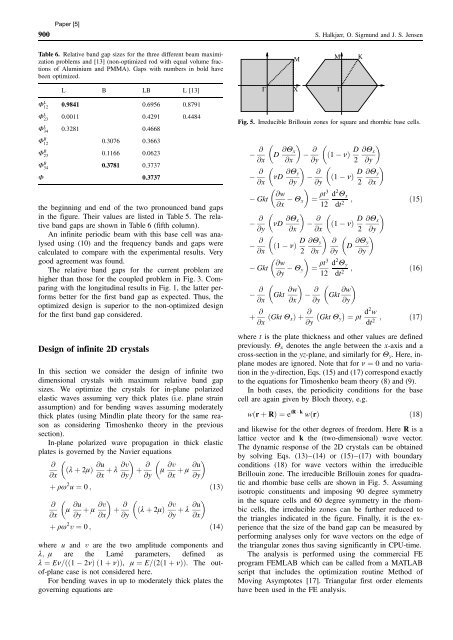WAVES AND VIBRATIONS IN INHOMOGENEOUS STRUCTURES ...
WAVES AND VIBRATIONS IN INHOMOGENEOUS STRUCTURES ...
WAVES AND VIBRATIONS IN INHOMOGENEOUS STRUCTURES ...
Create successful ePaper yourself
Turn your PDF publications into a flip-book with our unique Google optimized e-Paper software.
900 S. Halkjær, O. Sigmund and J. S. Jensen<br />
Table 6. Relative band gap sizes for the three different beam maximization<br />
problems and [13] (non-optimized rod with equal volume fractions<br />
of Aluminium and PMMA). Gaps with numbers in bold have<br />
been optimized.<br />
the beginning and end of the two pronounced band gaps<br />
in the figure. Their values are listed in Table 5. The relative<br />
band gaps are shown in Table 6 (fifth column).<br />
An infinite periodic beam with this base cell was analysed<br />
using (10) and the frequency bands and gaps were<br />
calculated to compare with the experimental results. Very<br />
good agreement was found.<br />
The relative band gaps for the current problem are<br />
higher than those for the coupled problem in Fig. 3. Comparing<br />
with the longitudinal results in Fig. 1, the latter performs<br />
better for the first band gap as expected. Thus, the<br />
optimized design is superior to the non-optimized design<br />
for the first band gap considered.<br />
Design of infinite 2D crystals<br />
In this section we consider the design of infinite two<br />
dimensional crystals with maximum relative band gap<br />
sizes. We optimize the crystals for in-plane polarized<br />
elastic waves assuming very thick plates (i.e. plane strain<br />
assumption) and for bending waves assuming moderately<br />
thick plates (using Mindlin plate theory for the same reason<br />
as considering Timoshenko theory in the previous<br />
section).<br />
In-plane polarized wave propagation in thick elastic<br />
plates is governed by the Navier equations<br />
@<br />
@x<br />
ðl þ 2mÞ @u @v<br />
þ l<br />
@x @y<br />
þ @<br />
@y<br />
m @v @u<br />
þ m<br />
@x @y<br />
þ qw 2 u ¼ 0 ; ð13Þ<br />
@<br />
@x<br />
L B LB L [13]<br />
F L 12 0.9841 0.6956 0.8791<br />
F L 23 0.0011 0.4291 0.4484<br />
F L 34 0.3281 0.4668<br />
F B 12 0.3076 0.3663<br />
F B 23 0.1166 0.0623<br />
F B 34 0.3781 0.3737<br />
F 0.3737<br />
m @u @v<br />
þ m<br />
@y @x<br />
þ @<br />
@y<br />
ðl þ 2mÞ @v @u<br />
þ l<br />
@y @x<br />
þ qw 2 v ¼ 0 ; ð14Þ<br />
where u and v are the two amplitude components and<br />
l; m are the Lamé parameters, defined as<br />
l ¼ En=ðð1 2nÞð1 þ nÞÞ, m ¼ E=ð2ð1 þ nÞÞ. The outof-plane<br />
case is not considered here.<br />
For bending waves in up to moderately thick plates the<br />
governing equations are<br />
Γ<br />
@<br />
@x<br />
@<br />
@x<br />
D @Qx<br />
@x<br />
nD @Qy<br />
@y<br />
@<br />
@y<br />
@<br />
@y<br />
ð1 nÞ D<br />
2<br />
ð1 nÞ D<br />
2<br />
@Qx<br />
@y<br />
@Qy<br />
@x<br />
Gkt @w<br />
@x Qx ¼ qt3 d<br />
12<br />
2 Qx<br />
dt2 ; ð15Þ<br />
@<br />
@y<br />
@<br />
@x<br />
nD @Qx<br />
@x<br />
ð1 nÞ D<br />
2<br />
@<br />
@x<br />
@Qy<br />
@x<br />
ð1 nÞ D<br />
2<br />
@<br />
@y<br />
D @Qy<br />
@y<br />
@Qx<br />
@y<br />
Gkt @w<br />
@y Qy ¼ qt3 d<br />
12<br />
2 Qy<br />
dt2 ; ð16Þ<br />
@<br />
@x<br />
þ @<br />
@x<br />
M<br />
X<br />
Gkt @w<br />
@x<br />
ðGkt QxÞþ<br />
@<br />
@<br />
@y<br />
M K<br />
Fig. 5. Irreducible Brillouin zones for square and rhombic base cells.<br />
Gkt @w<br />
@y<br />
@y Gkt Qy ¼ qt d2w ; ð17Þ<br />
dt2 where t is the plate thickness and other values are defined<br />
previously. Qx denotes the angle between the x-axis and a<br />
cross-section in the yz-plane, and similarly for Qy. Here, inplane<br />
modes are ignored. Note that for n ¼ 0 and no variation<br />
in the y-direction, Eqs. (15) and (17) correspond exactly<br />
to the equations for Timoshenko beam theory (8) and (9).<br />
In both cases, the periodicity conditions for the base<br />
cell are again given by Bloch theory, e.g.<br />
wðr þ RÞ ¼e iR k wðrÞ ð18Þ<br />
and likewise for the other degrees of freedom. Here R is a<br />
lattice vector and k the (two-dimensional) wave vector.<br />
The dynamic response of the 2D crystals can be obtained<br />
by solving Eqs. (13)–(14) or (15)–(17) with boundary<br />
conditions (18) for wave vectors within the irreducible<br />
Brillouin zone. The irreducible Brillouin zones for quadratic<br />
and rhombic base cells are shown in Fig. 5. Assuming<br />
isotropic constituents and imposing 90 degree symmetry<br />
in the square cells and 60 degree symmetry in the rhombic<br />
cells, the irreducible zones can be further reduced to<br />
the triangles indicated in the figure. Finally, it is the experience<br />
that the size of the band gap can be measured by<br />
performing analyses only for wave vectors on the edge of<br />
the triangular zones thus saving significantly in CPU-time.<br />
The analysis is performed using the commercial FE<br />
program FEMLAB which can be called from a MATLAB<br />
script that includes the optimization routine Method of<br />
Moving Asymptotes [17]. Triangular first order elements<br />
have been used in the FE analysis.<br />
Γ

















